QUEZON CITY (MindaNews / 03 July) — I worked in Kulaman Valley, Sultan Kudarat. I covered the news of your loss there in the May 2010 Presidential elections, for MindaNews. Even before the votes were cast and counted, I already knew your fate and was just waiting for counting to be over for confirmation.
During our three-and-a-half-hour rickety bus ride through the tortuous road from Isulan to Kulaman, people were already telling each other not to vote for you even if their town is named after your father. We ran the story, “Noynoy Aquino loses election in Sen. Ninoy Aquino town” the day after the elections. You lost to former President Joseph Estrada.
Your sister, Viel Dee and her husband laughed at this when I told them the story during an event in Pamulaan School in a Davao university where Viel was a guest of honor in June 2010. She honestly didn’t know there was a town named Senator Ninoy Aquino and asked me the story how that happened. She quipped the local politicians didn’t have to name the town after your father for your mother to approve it when she was elected President.
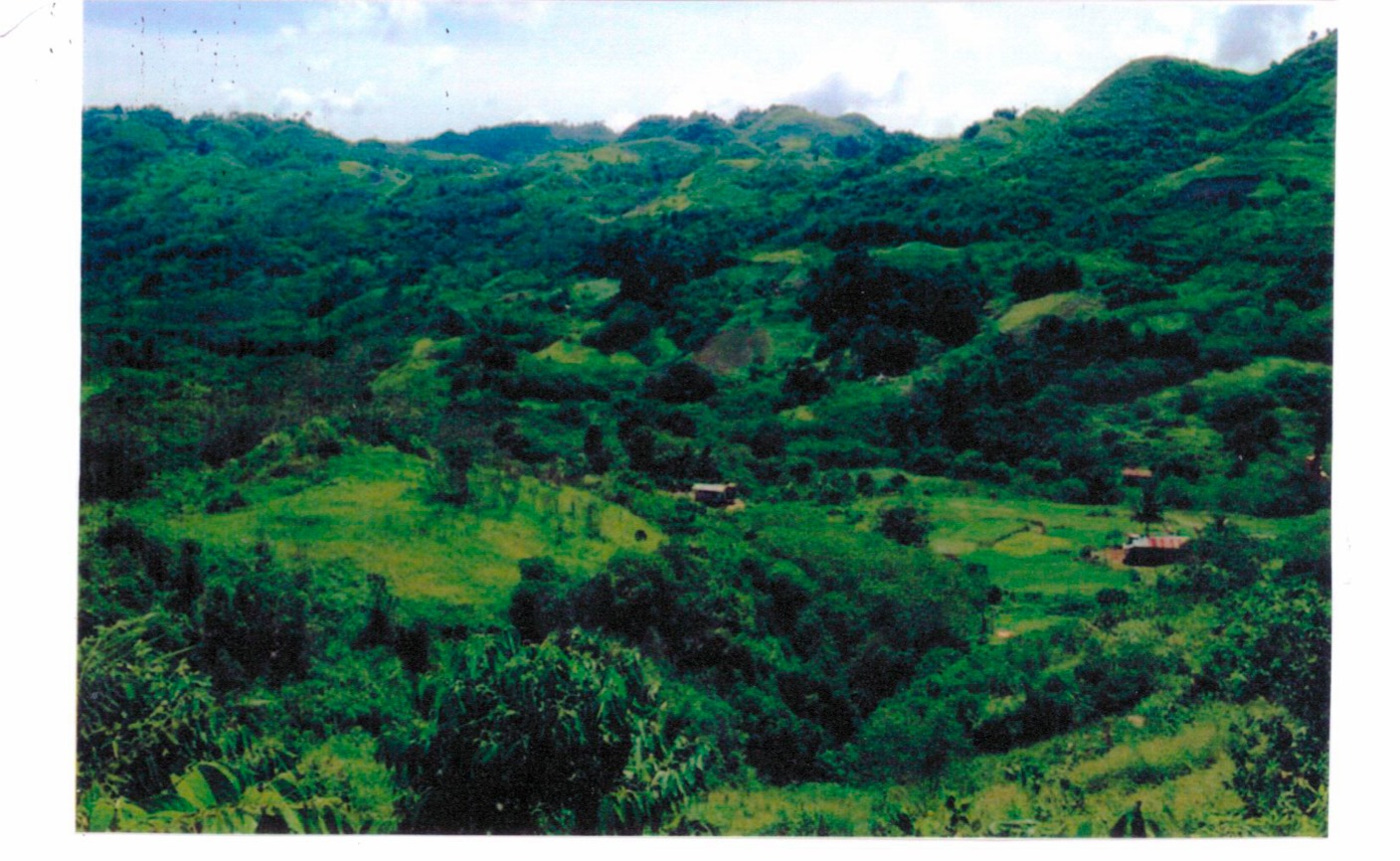 Sitio Lageton in Barangay Auden Senator Ninoy Aquino town in Sultan Kudarat province. Lageton is a Dulangan Manobo settlement located about 22 kilometers northeast of the town center. The place name comes from the word laget or tobacco, which the Dulangan Manobo continue to cultivate to this day. When the sitio proper became dominated by migrant settlers, the Dulangan Manobo moved to this area traditionally called Linabasan, two kilometers from the sitio proper to protect the spring and the waterfalls from encroachment. The area is the headwaters of the Tran River which empties into the Celebes Sea. Photo by BJ PATIÑO
Sitio Lageton in Barangay Auden Senator Ninoy Aquino town in Sultan Kudarat province. Lageton is a Dulangan Manobo settlement located about 22 kilometers northeast of the town center. The place name comes from the word laget or tobacco, which the Dulangan Manobo continue to cultivate to this day. When the sitio proper became dominated by migrant settlers, the Dulangan Manobo moved to this area traditionally called Linabasan, two kilometers from the sitio proper to protect the spring and the waterfalls from encroachment. The area is the headwaters of the Tran River which empties into the Celebes Sea. Photo by BJ PATIÑO
That may have been so but local politicians in the 1980s believed it would help speed up the passage of a bill creating Kulaman, then a barangay of Kalamansig town, if it would be named after Senator Ninoy Aquino.
Oldtimers in the area say that Kulaman was being groomed to be transformed into a town and was to be named after a Marcos relative to facilitate easy passage of the law in the then Marcos-controlled Batasang Pambansa. But in February 1986, People Power at EDSA drove the dictator Marcos out of power. To ensure quick passage of the law in the newly restored Congress, they changed the name to Sen. Ninoy Aquino town, carved from portions of Kalamansig and Bagumbayan towns.
Republic Act 6712, an act creating the municipality of Senator Ninoy Aquino in the province of Sultan Kudarat was “enacted without executive approval” on February 17, 1989. At that time, the senator’s widow, your mom Cory, was President. She did not affix her signature. It lapsed into law.
The last time I visited Kulaman in April 2016, the road construction from Isulan to Senator Ninoy Aquino town was underway. As with your other projects, there were no tarpaulins bearing your picture and your name to announce what you helped build there. The only notice about the construction activities was the Project budget bearing seal of the Commission of Audit and the signature of an auditor.
Through the Department of Education headed by Secretary Armin Luistro, your administration also approved the construction of a school in one of Kulaman’s farthest sitios, Lageton (also referred to as Lageten). The village, which is part of Barangay Kuden, is around 22 kilometers northeast of the Kulaman town center.
This was in response to a letter from a para-teacher who was teaching the children in their community at the same time doing adult literacy. The teacher’s name was Pelin Tagaken, a Dulangan Manobo. The letter was dated July 27, 2014.
The request for a school arose when our research team from Ateneo de Davao University – Ateneo Institute of Anthropology, was conducting a commissioned research on land access in aid of designing the National Community Driven Development Program (NCDDP) of the Department of Social Welfare and Development (DSWD) with funding support from the World Bank.
As part of research ethics, my colleague and I requestd if it could be guaranteed that our research sites be selected as project sites for the forthcoming program. When we were told that all sites will have to undergo the regular project site selection process, I discussed this with the community during our fieldwork before we underwent the validation for the Free and Prior Informed Consent process (FPIC) for the research project on July 30, 2014.
A long discussion among the leaders and community members ensued: they agreed to be a case study for the commissioned research so that their plight would be known by the government. They asked if there were other options. They described that given the local dynamics, there were no guarantees that their village would be selected as a Project site for NCDDP. All they wanted was for a school to be built in the village.
During that time, Pelin was already running a literacy project for children and adults with the support of the Oblates of Mary Immaculate (OMI) and the Religious of the Notre Dame Mission (RNDM), for the building, the school supplies, and her modest allowance. However, once the children reach school-age, they have to go to the town center and enroll in Notre Dame of Kulaman, with the OMI and RNDM’s support for tuition, school supplies, boarding house and food.
The town center is a four-hour walk, through a well-travelled footpath through Balatakan for the cash-strapped Manobo. At that time, the fare was 800 pesos per trip for a 1.5 hour motorcycle ride from Kulaman to Menting, the nearest drop-off point. The village is another 3.5 kilometers away, traversed on foot.
Because of this categorical request, I suggested that they try writing the Secretary of Department of Education. I said I will find ways to ensure that the letter reaches the Secretary’s office, but with no promises of positive response. I remember explaining to them that government processes at the national level are more complex than at the local level.
It took Pelin days to decide to write because it was going to be her first time.
On July 29, 2014, the night before the FPIC validation, Datu Koyo Tagaken, Pelin’s father and his party arrived at the convent where our research team was staying and handed me the letter. The letter was handwritten on a yellow pad paper and was carefully wrapped in an ice candy plastic. Among the people who were at the convent when the Datu arrived were Fr. Renante Aban, OMI who was the Head of the IP Ministry; Mr. James Ramirez, one of the local officials of the NCIP; the members of the research team; and the convent boys. I opened the letter and told everyone it was Lageton community’s request for the school.
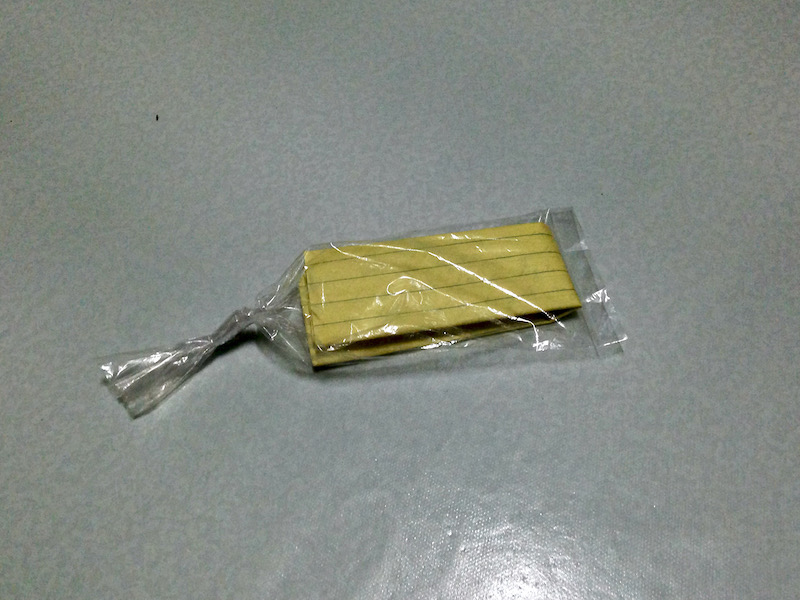 Letter wrapped in ice candy plastic sent to Education Secretary Armin Luistro in July 2014 from a Lumad in Sitio Legoton, Barangay Tinalon, Sultan Kudarat province, expressing hope a school would be built in their area. Photo by BJ PATIÑO
Letter wrapped in ice candy plastic sent to Education Secretary Armin Luistro in July 2014 from a Lumad in Sitio Legoton, Barangay Tinalon, Sultan Kudarat province, expressing hope a school would be built in their area. Photo by BJ PATIÑO
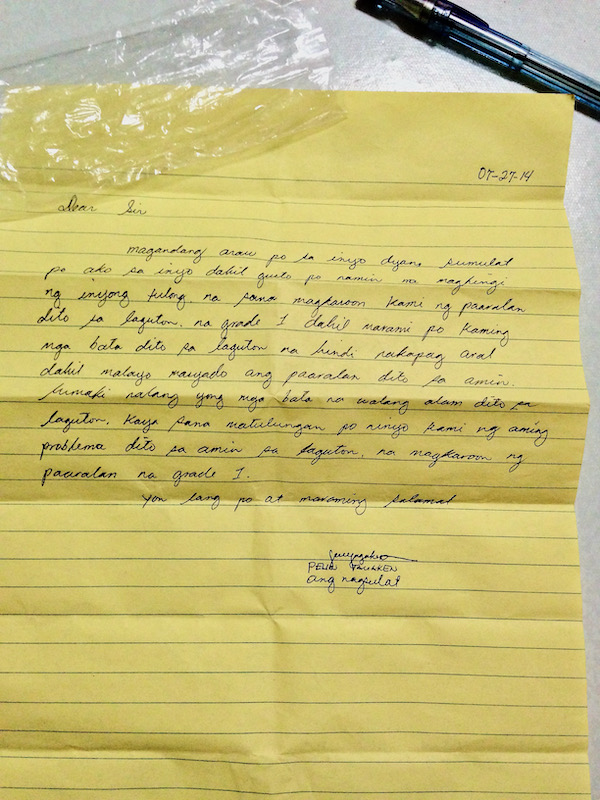 DEAR SIR. Para-teacher Pelin, a Lumad from Lageton in Senator Ninoy Aquino town in Sultan Kudarat province, wrote this letter in July 2014, expressing hope a school would be built in their area. The letter, wrapped in ice candy plastic, was sent to Education Secretary Armin Luistro. Pelin and her community got what they wished for. Photo by BJ PATIÑO
DEAR SIR. Para-teacher Pelin, a Lumad from Lageton in Senator Ninoy Aquino town in Sultan Kudarat province, wrote this letter in July 2014, expressing hope a school would be built in their area. The letter, wrapped in ice candy plastic, was sent to Education Secretary Armin Luistro. Pelin and her community got what they wished for. Photo by BJ PATIÑO
I waited for the opportunity for Butch Rufino, the Secretary’s staff, to come to Davao City. I knew Butch from Ugnayang Pang-Aghamtao – Anthropological Association of the Philippines (UGAT). I gave the letter to him without any fanfare after his meeting at Ateneo. We didn’t even have time for coffee for me to pitch the letter. We just talked briefly while we walked down the building and he waited for a taxi to bring him to his hotel.
When I handed him the letter with a number of pictures to give the community a face and a post it note of the contact details of the head of the IP Ministry, he just said to me nonchalantly, “we get all kinds.” I wanted to think his poker-face response was only due to tiredness from his marathon meetings. While a friend who was a friend of the Secretary could have sent a text message about the letter, we decided not to, to see how far the letter would go and how the administration would respond. Then the community could really claim that the school was built though their own effort, finding their own voice to tell the government what they needed most.
Sometime in 2015, I was told by Fr. Aban that some DepEd officials from the region visited Lageton to check the area. It was uncertain if there was going to be another visit.
It was Mr. Ramirez who told me that the school in Lageton was built when we serendipitously met each other in Manila for NCIP’s 21st IPRA celebration in 2018. He thought I should know this because I was never able to go back to Kulaman since 2016. I confirmed with the staff of Sec. Luistro about the school, and he said the budget for the construction of the school and the hiring of teachers were already allocated before your term ended.
When you passed on on June 24, Butch Rufino sent me a copy of the Special Allotment Release Order (SARO) issued on May 17, 2016, by the Department of Budget and Management, amounting to 500M pesos “for the construction of 605 classrooms in 261 sites in Regions 9, 10, 11, 12 and 13 for Indigenous Peoples in Mindanao,” Lageton included, “per Office of the President approval dated 4 May 2016.” Butch also told me the heartwarming story that you personally knew this initiative.
Through various shares of my FB post about the beginnings of the Lageten Elementary School, I learned more details about it.
Its first teachers were hired in June 2016. The school was initially placed under Sewal Elementary School until they became independent with their own ID on September 16, 2016. Currently, the school has four permanent teachers teaching 150 pupils from kindergarten to Grade 6.
Since it started operating in June 2016 to this day, the school has been using the De Mazenod Center of the OMI to hold classes while the two school buildings are being built under the Construction of Classrooms for Lumad Project of the NCCDP. The almost five-hectare land where the school was constructed was donated by the families of two village leaders in Lageton – the Tagaken and the Beto. According to the Office in Charge of the school. Dennis Fajardo, as of June 2021, the school buildings have yet to be turned over to DepEd.
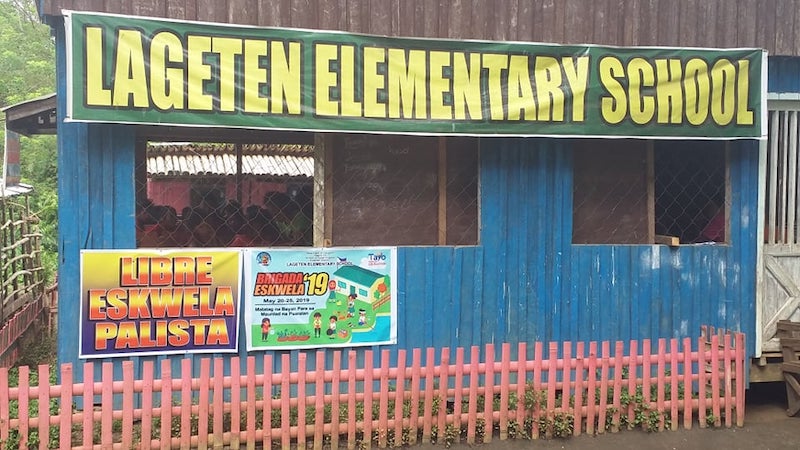 While the permanent structures of the Lageten Elementary School were being constructed, the De Mazenod Center of the Oblates of Mary Immaculate served as their temporary classrooms. Photo courtesy fo Dennis Galasinao Fajardo
While the permanent structures of the Lageten Elementary School were being constructed, the De Mazenod Center of the Oblates of Mary Immaculate served as their temporary classrooms. Photo courtesy fo Dennis Galasinao Fajardo
To help implement the National Indigenous National Indigenous Peoples Education (IPEd) Program, also a milestone in your administration, Pelin was engaged as an IPEd volunteer teacher. She receives allowance from Barangay Kuden. She is currently preparing for her Licensure Exam for Teachers (LET). Her co-teacher, Shirley Vallinas, who was her classmate in college hopes she will pass with flying colors so that she could be promoted as the school’s head. She described that Pelin is really a very effective teacher because she knows their language and their culture. Two more volunteer teachers were engaged this year, one of whom is also a Dulangan Manobo from the village.
Ms. Vallinas recalled that the Dulangan Manobo loved their first teachers so much that the community members brought them rice during the harvest season and ensured that the teachers had constant supply of firewood in the building where they stayed. The parents are very supportive of their school activities and are very dependable whenever the teachers need their help, like in Brigada Eskwela.
Ms. Vallinas shared that during the school’s first recognition program, all the church workers in Kulaman — the priests and the nuns came to celebrate with them. “It was so beautiful and touching,” she said.
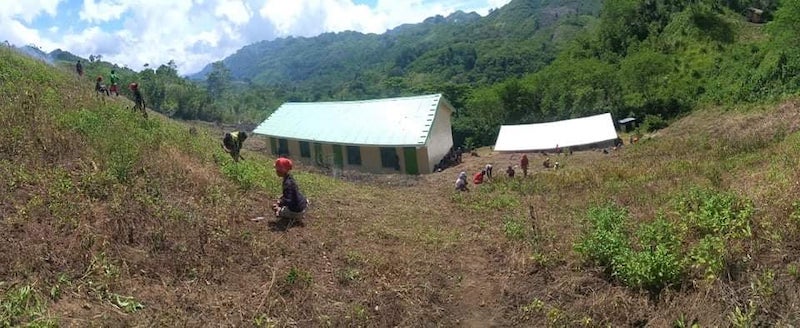 Lageten Elementary School in April 2021 during.a ‘Brigadea Eskwela’ clean-up. The newly-constructed school has yet to be turned over. The project was started in the last days of the Aquino administration in 2016 and was implemented under the Duterte administration. Photo courtesy of Dennis Galasinao Fajardo
Lageten Elementary School in April 2021 during.a ‘Brigadea Eskwela’ clean-up. The newly-constructed school has yet to be turned over. The project was started in the last days of the Aquino administration in 2016 and was implemented under the Duterte administration. Photo courtesy of Dennis Galasinao Fajardo
I can imagine. The school was an answer to a simple aspiration. As Datu Koyo, Pelin’s father told us then, gusto nila magkaroon ng school para matutong magbasa, sumulat at magkwenta para di na sila maloko sa lupa, sa pagtinda ng produkto, at sa pagboto (they wanted a school so they could learn how to read, write and count so that they would not be duped in land transactions, selling of products, and in voting).
I don’t know to whom they gave credit the school to when they opened it. I didn’t dare ask because I know the truth.
But more than the school, what I think as your greatest legacy because it was and is felt every day is the assertion of some indigenous communities I work with that, “Nilami ang bugas tung si PNoy ang na-President. Kumpara tung si GMA, ang bugas di gyud maantos.” Now, they complain, “swerte na lang kung naay bugas nga makaon” (We could afford to eat good quality rice when PNoy was President. During the time of GMA, we couldn’t eat the rice sold because it was foul-smelling. Now, we are just lucky if we get to eat rice at all).
Let me have my moment to grieve for what our country has become after you stepped down as President.
Thank you, President Noynoy Aquino for your service.
[MindaViews is the opinion section of MindaNews. Eizel Hilario is a cultural anthropologist who lived in Kulaman Valley (Senator Ninoy Aquino municipality) in 2004-2005 as a volunteer researcher for the Human Security Project jointly implemented by the Indigenous Peoples Apostolate, Oblates of Mary Immaculate and the Redemptorist Itinerant Mission with funding support from Assisi Development Foundation. She continued doing fieldwork in the area until 2016 for various research projects. The Dulangan Manobo in Kulaman named her Okon, which means young girl or little sister].
